Qualcomm Snapdragon S4 (Krait) Performance Preview - 1.5 GHz MSM8960 MDP and Adreno 225 Benchmarks
by Brian Klug & Anand Lal Shimpi on February 21, 2012 3:01 AM EST- Posted in
- Smartphones
- Snapdragon
- Qualcomm
- Adreno
- Krait
- Mobile
The MSM8960 is an unusual member of the Krait family in that it doesn't use an Adreno 3xx GPU. In order to get the SoC out quickly, Qualcomm paired the two Krait cores in the 8960 with a tried and true GPU design: the Adreno 225. Adreno 225 itself hasn't been used in any prior Qualcomm SoC, but it is very closely related to the Adreno 220 used in the Snapdragon S3 that we've seen in a number of recent handsets.
Compared to Adreno 220, 225 primarily adds support for Direct3D 9_3 (which includes features like multiple render targets). The resulting impact on die area is around 5% and required several months of work on Qualcomm's part.
From a compute standpoint however, Adreno 225 looks identical to Adreno 220. The big difference is thanks to the 8690's 28nm manufacturing process, Adreno 225 can now run at up to 400MHz compared to 266MHz in Adreno 220 designs. A 50% increase in GPU clock frequency combined with a doubling in memory bandwidth compared to Snapdragon S3 gives the Adreno 225 a sizable advantage over its predecessor.
| Mobile SoC GPU Comparison | |||||||||||
| Adreno 225 | PowerVR SGX 540 | PowerVR SGX 543 | PowerVR SGX 543MP2 | Mali-400 MP4 | GeForce ULP | Kal-El GeForce | |||||
| SIMD Name | - | USSE | USSE2 | USSE2 | Core | Core | Core | ||||
| # of SIMDs | 8 | 4 | 4 | 8 | 4 + 1 | 8 | 12 | ||||
| MADs per SIMD | 4 | 2 | 4 | 4 | 4 / 2 | 1 | 1 | ||||
| Total MADs | 32 | 8 | 16 | 32 | 18 | 8 | 12 | ||||
| GFLOPS @ 200MHz | 12.8 GFLOPS | 3.2 GFLOPS | 6.4 GFLOPS | 12.8 GFLOPS | 7.2 GFLOPS | 3.2 GFLOPS | 4.8 GFLOPS | ||||
| GFLOPS @ 300MHz | 19.2 GFLOPS | 4.8 GFLOPS | 9.6 GFLOPS | 19.2 GFLOPS | 10.8 GFLOPS | 4.8 GFLOPS | 7.2 GFLOPS | ||||
We turn to GLBenchmark and Basemark ES 2.0 V1 to measure the Adreno 225's performance:
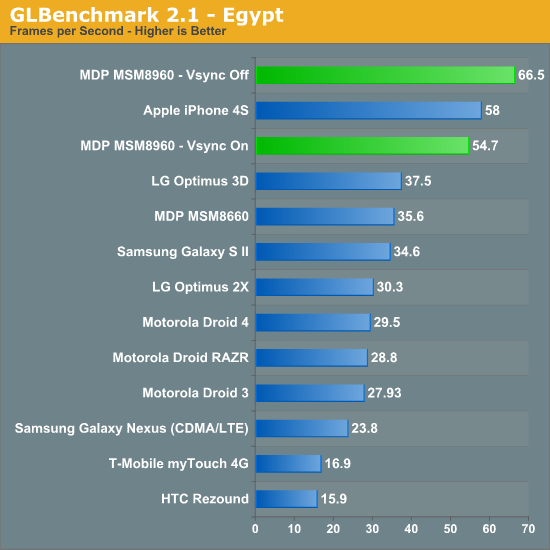
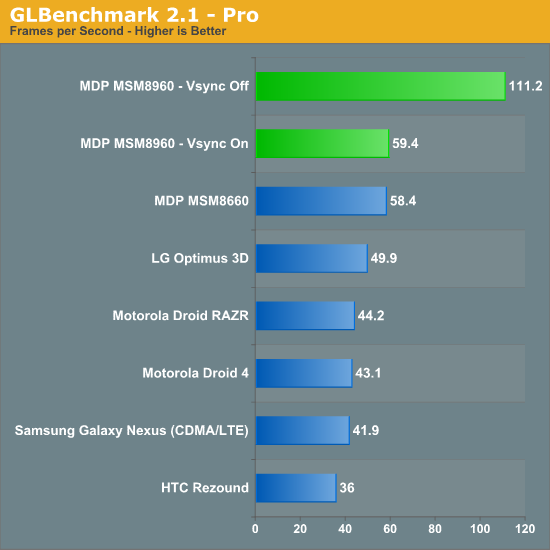
Limited by Vsync the Adreno 225 can actually deliver similar performance to the PowerVR SGX 543MP2 in Apple's A5. However if we drive up the resolution, avoid vsync entirely and look at 720p results the Adreno 225 falls short. Its performance is measurably better than anything else available on the Android side in the Egypt benchmark, however the older Pro test still shows the SGS2's Mali-400 implementation as quicker. The eventual move to Adreno 3xx GPUs will likely help address this gap.

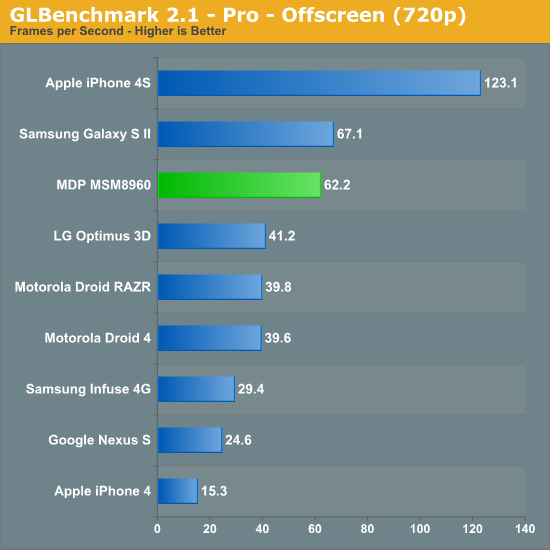
Basemark ES 2.0 tells a similar story (updated: notes below):
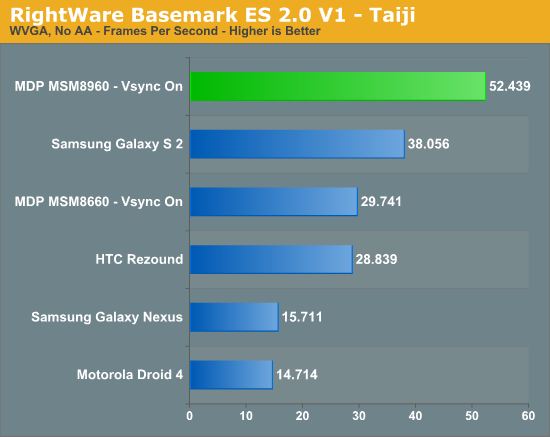
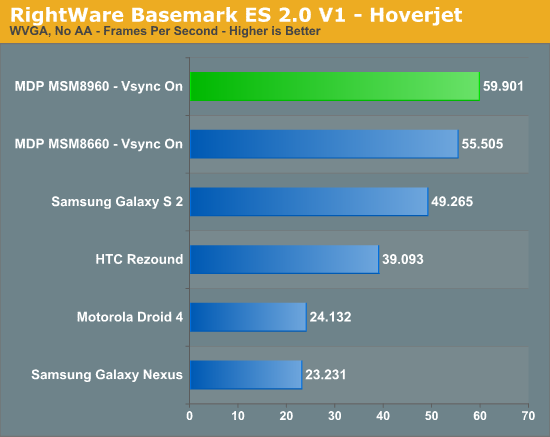
In the original version of this article we noticed some odd behavior on the part of the Mali-400 MP4 based Samsung Galaxy S 2. Initially we thought the ARM based GPU was simply faster than the Adreno 225 implementation in the MSM8960, however it turns out there was another factor at play. The original version of Basemark ES 2.0 V1 had anti-aliasing enabled and requested 4X MSAA from all devices that ran it. Some GPUs will run the test with AA disabled for various reasons (e.g. some don't technically support 4X MSAA), while others (Adreno family included) will run with it enabled. This resulted in the Adreno GPUs being unfairly penalized. We've since re-run all of the numbers with AA disabled and at WVGA (to avoid hitting vsync on many of the devices).
Basemark clearly favors Qualcomm's Adreno architecture, whether or not that's representative of real world workloads is another discussion entirely.
The results above are at 800 x 480. We're unable to force display resolution on the iOS version of Basemark so we've got a native resolution comparison below:
| RightWare Basemark ES 2.0 V1 Comparison (Native Resolution) | ||||
| Taiji | Hoverjet | |||
| Apple iPhone 4S (960 x 640) | 16.623 fps | 30.178 fps | ||
| Qualcomm MDP MSM8960 (1024 x 600) | 40.576 fps | 59.586 fps | ||
Even at its lower native resolution, Apple's iPhone 4S is unable to outperform the MSM8960 based MDP here. It's unclear why there's such a drastic reversal in standing between the Adreno 225 and PowerVR SGX 543MP2 compared to the GLBenchmark results. Needless to say, 3D performance can easily vary depending on the workload. We're still in dire need of good 3D game benchmarks on Android. Here's hoping that some cross platform iOS/Android game developers using Epic's UDK will expose frame rate counters/benchmarking tools in their games.










86 Comments
View All Comments
BaronMatrix - Tuesday, February 21, 2012 - link
We can look at the perf of CedarTrail or Ivy Blossom or whatever. Since Intel has said they are more so competing with Qualcomm. And this is only at 1.5GHz. When the 2.5Ghz chips come out with the new Adreno (Former ATi GPU), everyone will have to pack up and go home.iwod - Tuesday, February 21, 2012 - link
The rumors of Apple A5X leads some to suggest next iPad would not be 28nm SoC. So this prove we may still have chance of 28nm SoC coming in next iPad.Krait is bringing A15 level performance while being on a A9 class core?? Sorry i must be missing something. Or Since Krait is designed by Qualcomm A9 and A15 naming doesn't matter? (o.O)
No Mention of comparison to Intel newest Atom?
infra_red_dude - Tuesday, February 21, 2012 - link
Correct, Krait cannot be directly compared to A9 or A15 architecture. I think calling Krait contemporary to A15 is more correct than "A15/9-class" CPU.snoozemode - Tuesday, February 21, 2012 - link
It's really about time you can plug in your mobile to computer screen and run the Tablet UI, preferably at native resolution. Don't know what I would need this processing power to otherwise.tipoo - Tuesday, February 21, 2012 - link
This is very obviously faster than something like the Tegra 3 in single or dual threaded performance, I wonder how many apps take advantage of more than two threads on Android or iOS? I'm guessing for the foreseeable future faster duals will win out.remixfa - Tuesday, February 21, 2012 - link
Can Brian Klug & Anand Lal Shimpi please clarify for me which version of the SGS2 is being used? Its a very pertinent question. Is it the i9000 with the 1.2ghz Exynos chip or the American Hercules T989/Skyrocket variants that have the lesser Snapdragon 1.5ghz chips in them.Judging from the benchmarks, it really makes me think its the hercules/skyrocket. That really needs to be clarified, since unfortunately not all SGS2s are created equal.
Brian Klug - Tuesday, February 21, 2012 - link
The SGS2 used in the article is the UK SGS2 with Exynos 4210 inside.-Brian
larry6hi5 - Tuesday, February 21, 2012 - link
On page 1 of the article, the first table gives the MSM8660 as running at 1.5 GHz. Shouldn't this be 1.0 GHz?Brian Klug - Tuesday, February 21, 2012 - link
That's because the MSM8660 is indeed at 1.5 GHz :)If you go back to our original MDP article we note it there: http://www.anandtech.com/show/4243/
And also the official MDP MSM8660 page: https://developer.qualcomm.com/develop/development...
-Brian
ncb1010 - Tuesday, February 21, 2012 - link
"Even at its lower native resolution, Apple's iPhone 4S is unable to outperform the MSM8960 based MDP here"1024 x 600 = 614,400 pixels
960 x 640 = 614,400 pixels
There is no basis for saying the iPhone 4S has a lower resolution than this MDP being evaluated.